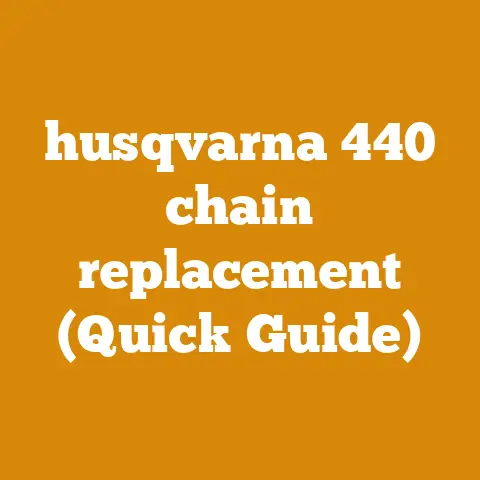Milwaukee Cordless Chain Saw (4 Game-Changing Features)
Introduction: The Revolution of Cordless Chainsaws
So, have you noticed how cordless tools are reshaping the landscape of power equipment? It’s amazing, right? A few years back, I was skeptical about whether cordless chainsaws could match the power of their gas counterparts. But times have changed, and when I first used the Milwaukee Cordless Chainsaw, I was genuinely impressed.
Embracing the Cordless Trend
Why are so many people switching to cordless? Well, it’s all about convenience and performance without the hassle of cords or gas. Imagine working in your backyard without tripping over cables or dealing with the fumes from gas-powered tools. That’s what cordless chainsaws offer—a breath of fresh air in tool technology.
Game-Changing Features of the Milwaukee Cordless Chainsaw
Now, let’s dig into what makes the Milwaukee Cordless Chainsaw stand out in this cordless revolution. There are four game-changing features that I’ve found truly impressive.
1. Powerful Brushless Motor
What Makes Brushless Motors Special?
I remember the first time I used a brushless motor tool; it felt like I was stepping into the future. But what exactly makes brushless motors so special?
Brushless motors differ from traditional motors because they don’t have brushes that wear out over time. Instead, they use magnets for rotation, which significantly reduces friction and wear. This means longer life and consistent performance.
- Example: Last summer, I was tasked with clearing out a neighbor’s overgrown backyard. Armed with my Milwaukee Cordless Chainsaw, I tackled those stubborn, thick branches without breaking a sweat. The power was constant, and I didn’t have to worry about it dying midway through.
Advantages Over Traditional Motors
- Efficiency: Brushless motors convert more electrical energy into mechanical energy.
- Durability: Less wear and tear mean fewer trips to the repair shop.
- Quiet Operation: Ever been annoyed by the loud roar of a gas chainsaw? Brushless motors operate much quieter.
2. REDLINK PLUS Intelligence
Understanding REDLINK PLUS
Now, let’s talk about REDLINK PLUS Intelligence—Milwaukee’s secret sauce for smart tool operation. It’s like having a mini-computer inside your chainsaw that constantly monitors its performance.
- Real-Life Scenario: Picture this: You’re cutting through a particularly tough piece of wood, and suddenly, your chainsaw adjusts its power output to prevent overheating. That’s REDLINK PLUS at work.
Benefits of Smart Technology
- Overload Protection: Prevents damage by cutting off power when necessary.
- Efficiency Optimization: Adjusts power output for optimal use.
- Battery Management: Extends battery life by managing charge and discharge cycles.
3. High-Output HD12.0 Battery
Why Battery Matters
We all know the frustration of a dying battery right in the middle of a project. That’s why the High-Output HD12.0 battery is a game-changer.
- Personal Experience: During a community tree-cutting event last fall, my Milwaukee Chainsaw outlasted others on a single charge. No more running back and forth for battery swaps!
Key Features of HD12.0 Battery
- Longer Run Time: Spend more time working and less time charging.
- Consistent Power: Maintains power levels even as the battery depletes.
- Durability: Built to withstand heavy-duty tasks without faltering.
4. Ergonomic Design and Balance
Importance of Ergonomics
Have you ever used a tool that just felt right in your hands? That’s what Milwaukee aims for with their ergonomic design.
- Storytime: I recall a long day trimming trees around my property. The chainsaw’s balanced weight distribution made the task feel less like work and more like fun.
Design Elements That Matter
- Grip Comfort: Soft handles reduce strain during prolonged use.
- Weight Distribution: Balanced design minimizes fatigue.
- Maneuverability: Easy to handle in tight spots and challenging angles.
Preparing to Use Your Milwaukee Cordless Chainsaw
Before diving into your next project, preparation is key. Whether you’re a seasoned pro or a newbie, here’s what you need to know.
Prerequisite Knowledge
Understanding how chainsaws work can save you headaches later on:
- Basic operation principles
- Safety protocols and emergency procedures
- Maintenance routines for longevity
Required Materials
Gather these essentials before you start:
- Milwaukee Cordless Chainsaw
- Safety gear (gloves, helmet, eye protection)
- Fully charged HD12.0 battery
- Chainsaw oil
Step-by-Step Guide to Using Your Chainsaw
Let’s walk through using your chainsaw effectively and safely.
Step 1: Safety Gear Check
Safety is always first. Never skip this step:
- Wear appropriate clothing: long sleeves and pants.
- Equip yourself with gloves, helmet, and goggles.
- Ensure your footwear has good grip—avoid sandals or open shoes.
- Tip: Check that your safety gear is in good condition before each use.
Step 2: Inspect Your Chainsaw
Before powering up, inspect your chainsaw thoroughly:
- Check chain tension: It should be tight but not overly so.
- Inspect for any visible damage or wear.
- Ensure all screws and bolts are secure.
- Tip: Familiarize yourself with your chainsaw’s parts for quick troubleshooting.
Step 3: Power Up Safely
Here’s how to get your chainsaw ready for action:
- Insert the fully charged HD12.0 battery securely.
- Activate the power button while ensuring no one is nearby.
- Test run briefly to check for smooth operation.
- Warning: Avoid starting near flammable materials or hazardous environments.
Step 4: Adjust Chain and Oil
Proper chain tension and lubrication are crucial:
- Use the tension adjustment knob for precise control.
- Apply chainsaw oil along the chain for smooth operation.
- Caution: Running without oil can damage the chain and reduce efficiency.
Step 5: Cutting Techniques
Now you’re ready to cut! Follow these steps for effective cutting:
- Firmly grip the saw with both hands.
- Start with a slow cut to gain control.
- Increase speed gradually for thicker wood.
- Avoid forcing the saw; let it do the work.
- Caution: Maintain a stable stance to prevent kickback or loss of control.
Troubleshooting Tips
Even with advanced technology, hiccups happen. Here’s how to address common issues:
Chainsaw Won’t Start?
Check these potential problems:
- Battery charge level
- Proper battery insertion
- REDLINK PLUS status indicator
Chain Doesn’t Rotate?
Possible causes include:
- Chain too tight or too loose
- Debris blocking movement
- Insufficient lubrication
Best Practices for Maintenance
To keep your chainsaw in top shape, regular maintenance is essential:
- Clean after each use to remove debris.
- Sharpen the chain regularly—dull blades make work harder.
- Inspect for wear and replace parts as needed.
- Store in a dry place away from moisture.
- Tip: Keep spare chains on hand for quick swaps during prolonged tasks.
Common Questions and Concerns
New users often have similar queries about their chainsaws:
Can I use other Milwaukee batteries with my chainsaw?
While some might fit, stick with the HD12.0 for optimal performance and longevity.
How often should I oil the chain?
Oil before each session and check periodically during longer tasks to ensure smooth operation.
Is it safe to use in wet conditions?
Avoid using in rain or damp environments to prevent electrical hazards and ensure user safety.
Important Reminders and Next Steps
Now that you’re all set up with your Milwaukee Cordless Chainsaw, remember these key points:
- Prioritize safety at all times.
- Keep your chainsaw well-maintained for efficient performance.
- Familiarize yourself with troubleshooting tips to handle any issues quickly.
- Consider joining forums or groups to share experiences and learn from other users’ insights.
By following these guidelines, you’ll not only become proficient with your chainsaw but also enjoy every project you tackle.
FAQs
Here’s a quick FAQ section to address common concerns:
Q: How do I store my chainsaw properly?
A: Store it in a dry place with the battery removed to prevent accidental activation or damage.
Q: What’s the best way to sharpen the chain?
A: Use a round file designed for your chain size; follow manufacturer instructions for best results.
Q: Can I replace parts myself or should I seek professional help?
A: Simple replacements like chains can be done at home; consult professionals for complex repairs or if unsure.






